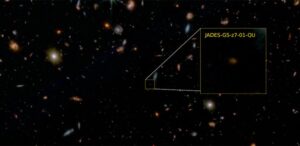
In a paper in Nature, with Tobias Looser as the first author, researchers discuss a galaxy cataloged as JADES-GS-z7-01-QU. This license plate of a system is shining at us from 700 million years after the Big Bang, and, as near as the researchers can tell, it has already stopped star formation and has a light signature consistent with its youngest stars being 10-20 million years old. This implies that this system formed, underwent a brief and intense period of star formation, and then stopped. Just stopped. The word they use is “died”.
But it’s only mostly dead, and there’s a big difference between mostly dead and all dead. Mostly dead is still capable of coming back to life and forming new stars in the future. [Editor’s note: “With all dead, there’s usually only one thing you can do – go through his clothes and look for loose change.”]
According to paper co-author Francesco D’Eugenio, “We’re looking for other galaxies like this one in the early universe, which will help us place some constraints on how and why galaxies stop forming new stars. It could be the case that galaxies in the early universe ‘die’ and then burst back to life – we’ll need more observations to help us figure that out.”
What is remarkable about all of this is the size of the galaxy: about the size of the Small Magellanic Cloud, a dwarf galaxy near our own Milky Way that is visible in the Southern Hemisphere. We are seeing a dwarf galaxy shining from the beginning of the universe. And from 13 billion light years away we can see it behaving in unexpected ways.
As Maiolino, a co-author on this paper, puts it, “Until now, to understand the early universe, we’ve used models based on the modern universe. But now that we can see so much further back in time, and observe that the star formation was quenched so rapidly in this galaxy, models based on the modern universe may need to be revisited.”
And this is where I am glad for modern computing power.
